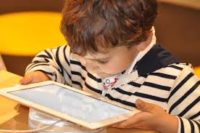
An increasing number of educators are being asked to include technology in their lessons. I have seen the term technology included as a component of teacher evaluations, within state level teaching standards, and embedded within national content standards. I teach a class to intern teachers that is entitled “Technology in the Classroom”. It is a required course for many interns in the program.
Compliance Leads to Isolation
In an effort to meet the demand for technology use in a classroom setting, many educators look for an educational app, program, or game to accompany their lesson. Technology becomes a box to check off. It is used as a compliance measure. Students may stare at their devices for a specified amount of the day engaging with a digital screen. Many times, the task isolates students from peers and does not clearly align to other learning experiences that occur in the classroom.
Connections Fuel Learning
Neuroscience teaches us that in order for learning to be sustained and strengthened, connections must be made in the brain. Rather than isolating technology activities as stand-alone events, it is vital that we fuse them together with learning from throughout the day. Technology is best used in the classroom within the context of academic learning experiences. It should be fluid, used not as a separate activity, but accessed anytime it enhances the learning experience.
Seek Connections
As I visit classrooms, I observe the habitat. In viewing student work on desks, listening to conversations, and noticing instructional posters on the walls, I am constantly seeking to align technology strategies to the context of the learning experiences present in each classroom. It is rewarding to discover these potential connections. Yet as a coach, it is even more gratifying to observe teachers make connections themselves.
Real Life Examples from Teachers
Example 1: Booksnaps and RACE

A middle school teacher I work with was eager to introduce booksnaps to his students. I gave a brief demo to his students, demonstrating how to use google slides to insert an image of a page of a book they were reading, use the line tool to underline particular text, add a relevant image, and cite evidence/provide explanation in the speaker notes. On the white board, I had noticed that students were learning about the theme of a literary work. Therefore, the booksnap contained a text citation that supported their claim as to this literary element.
After the demo, the teacher pointed out what I had typed in the speaker notes and exclaimed, “This is just like the RACE strategy we have been using!” He referred to a chart on the board and instructed students to be sure to use this strategy when using booksnaps. The technology was seen not as isolated, but connected to other instructional strategies used in the class.
Example 2: Flipgrid and Accountable Talk

I spoke with an elementary teacher who was interested in enhancing academic conversations in her classroom. I immediately suggested flipgrid and helped her to set up an account and prepare to implement this video discussion platform later that day. Students first recorded a response to a prompt. As one of the students began to reply to a peers’ video, he asked his teacher, “Can I use accountable talk, like we’ve been learning about?” “Of course!” the teacher exclaimed. The student had made a connection between the technology platform being used, and a non-tech tool he had experienced earlier that day. Flipgrid was not an isolated “technology” activity, it was an integrated method that fueled academic learning.
Be sure to actively seek connections across the learning experiences in your classroom. And for even greater impact, ask your learners themselves for possible connections and/or extensions they see. Beware of isolation. It is connection that strengthens learning.
